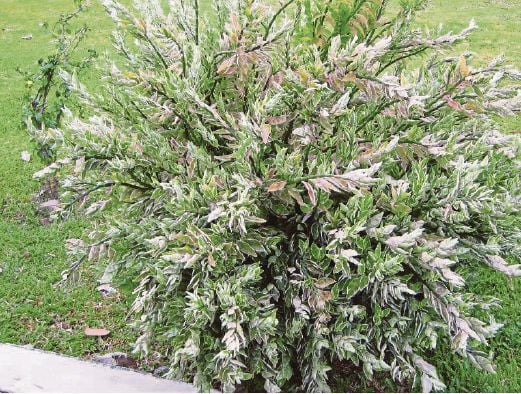Sturdy and tough, the Euphorbia tithymaloides, sometimes referred to as Christmas candles, is a good shrub to grow as a hedge, writes Stephanie Choo
A VERY robust plant, Euphorbia tithymaloides has been a long-time garden favourite and a good shrub to grow as hedge.
Viewed close-up, the plant produces peculiar blooms, leaves and form, hence its many colloquial names. Perhaps also due to its blooms which resemble burning candles, some call it Christmas candle.
PLANT FACT
The plant is also known as redbird cactus, Jacob’s ladder, zig-zag plant, Japanese poinsettia, devil’s backbone, lelipan, penawar lipan and slipper spurge.
Euphorbia tithymaloides is a member of the genus Euphorbia and belongs to the spurge family (Euphorbiaceae). Previously, it was classified under the Pedilanthus genus.
The half-woody succulent spurge is a perennial which grows upright to about 1.5m high. It is native to the subtropical and tropical parts of North America and Central America.
The zigzag fleshy stems, leaves and roots produce milky latex which is considered toxic and irritates eyes. The leaves are alternately arranged, in green or variegated, ovate and about 3.5 to 7.5cm long and 2.5 to 5cm wide.
The cyathia or inflorescences consist of small flowers, enclosed by bright reddish-pink, elf-slipper bracts. These bracts are borne in terminal clusters on short leafless stems. The seed capsules are about 9mm in diameter.
In folk medicine, tea made with the leaves is used to treat cough, asthma and mouth ulcer. The sap is used to heal ear-ache, insect bites, skin cancer, callouses, ring worm and toothache.
VARIETIES
The dwarf form of the plant, E. tithymaloides ssp. smallii ‘Nanus’ has green leaves that are closely laid out in two rows and grow to about 35cm high only. There are other varieties and they differ in leaf arrangements, size (dwarf to medium shrubs that are about 1 to 1.5m tall) and leaf colour cum shape.
The smallii variety has curly leaves while the smallii ‘Albino’ variety possesses white, yellow and green variegated leaves. The smallii ‘Embraceable You’ variety has leaves that are crinkled, cupped, greyish-green with white margin. Meanwhile, the variegated leaves of the smallii ‘Variegatus’ variety is in shades of cream, yellow, green and pink.
USES
All varieties are great for container gardening as well as rock gardens - either in pots or the ground. These clump-forming succulent shrubs tolerate tough conditions and drought well. They can be planted as a standalone bush clump or mixed with other shrubs. The mini type, ‘Nanus’, is a suitable choice for beautifying green roofs as it also flourishes well in shallow media.
Though they can survive without much fuss, if well-tended, the medium-sized and more compact growing E. tithymaloides varieties are great candidates for creating beautiful low trimmed or untrimmed hedges and borders in a landscape.
HOW TO GROW
E. tithymaloides varieties are generally fast growing and well-branched. Prune the young plants regularly for denser growth and to form a well-shaped hedge if they are planted in a row.
They can be grown in partial sun. For best colouration, cultivate the plant in full sun. With more sunlight, the variety ‘Variegatus’ blushes in reddish-pink more prominently.
Use well-draining soil and repot only when the plant has outgrown the original pot. Water it daily if grown in full sun. The plant requires only a little fertiliser to develop. So you can feed the plant occasionally with any balanced fertiliser or even sheep/chicken manure pellets.Prune the plant by half to two-third to prevent unsightly leggy appearance.


No comments:
Post a Comment